
Hollywood and Vine, the intersection of Hollywood Boulevard and Vine Street in Hollywood, California, became known in the 1920s for its concentration of radio and movie-related businesses. The Hollywood Walk of Fame is centered on the intersection.

Hollywood Boulevard is a major east–west street in Los Angeles, California. It runs through the Hollywood, East Hollywood, Little Armenia, Thai Town, and Los Feliz districts. Its western terminus is at Sunset Plaza Drive in the Hollywood Hills and its eastern terminus is at Sunset Boulevard in Los Feliz. Hollywood Boulevard is famous for running through the tourist areas in central Hollywood, including attractions such as the Hollywood Walk of Fame and the Ovation Hollywood shopping and entertainment complex.
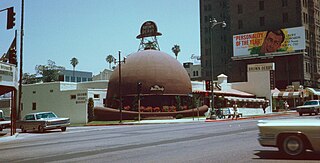
Brown Derby was a chain of restaurants in Los Angeles, California. The first and best known was shaped like a derby hat, an iconic image that became synonymous with the Golden Age of Hollywood. It was opened by Wilson Mizner in 1926. The chain was started by Robert H. Cobb and Herbert K. Somborn in the 1920s. The original Brown Derby restaurants had closed or had been converted to other uses by the 1980s, though a Disney-backed Brown Derby national franchising program revived the brand in the 21st century. It is often incorrectly thought that the Brown Derby was a single restaurant, and the Wilshire Boulevard and Hollywood branches are frequently confused.

The Formosa Cafe is a restaurant and bar founded in 1925 and located at 7156 Santa Monica Boulevard at the intersection with North Formosa Avenue, in West Hollywood, California.
S. H. Kress & Co. was the trading name of a chain of five and dime retail department stores in the United States established by Samuel Henry Kress. It operated from 1896 to 1981. In the first half of the 20th century, there were Kress stores with ornamented architecture in hundreds of cities and towns.

Nathan Road is the main thoroughfare in Kowloon, Hong Kong, aligned south–north from Tsim Sha Tsui to Sham Shui Po. It is lined with shops and restaurants and throngs with visitors, and was known in the post–World War II years as the Golden Mile, a name that is now rarely used. It starts on the southern part of Kowloon at its junction with Salisbury Road, a few metres north of Victoria Harbour, and ends at its intersection with Boundary Street in the north. Portions of the Kwun Tong and Tsuen Wan lines run underneath Nathan Road. The total length of Nathan Road is about 3.6 km (2.2 mi).

Ovation Hollywood is a shopping center and entertainment complex at the intersection of Hollywood Boulevard and Highland Avenue in the Hollywood neighborhood of Los Angeles, California, United States.

Cahuenga Boulevard is a major boulevard of northern Los Angeles, California, US. The “Cahuenga” name is a Spanish, phonetic derivative with no actual Spanish language meaning that is attributed to the Tongva village of Kawengna, meaning "place of the mountain". It connects Sunset Boulevard in the heart of old Hollywood to the Hollywood Hills and North Hollywood in the San Fernando Valley.

The Bankers Trust Company Building is an office building located at 205 West Congress Street in Downtown Detroit, Michigan, within the Financial District. Designed by Wirt C. Rowland of Smith, Hinchman & Grylls and completed in 1925 the ornately modeled building is an exquisite example of Italian Romanesque Revival architecture.
Armet Davis Newlove Architects, formerly Armét & Davis, is a Californian architectural firm known for working in the Googie architecture style that marks many distinctive coffee shops and eateries in Southern California. The firm designed Pann's, the first Norms Restaurants location, the Holiday Bowl and many other iconic locations.
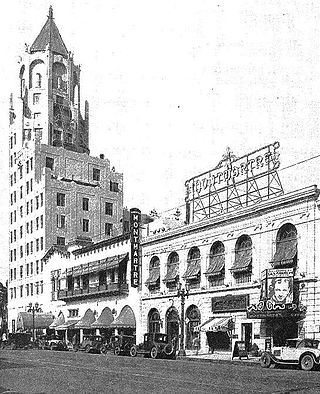
Café Montmartre was a restaurant and nightclub on Hollywood Boulevard at Highland Avenue in Hollywood, Los Angeles, California, US. Opened in 1923, it became a "worldwide center for celebrity and nightlife" during the 1920s and a place where tourists would visit to try to break into Hollywood.

Johnie's Coffee Shop is a former coffee shop and a well-known example of Googie architecture located on the corner of Wilshire Boulevard and Fairfax Avenue in Los Angeles, California. Architects Louis Armét and Eldon Davis of Armét & Davis designed the building, contributing to their reputation as the premier designers of Space Age or Googie coffee shops—including the landmark Pann's coffee shop in Ladera Heights, Norms Restaurant on La Cienega Boulevard, and several Bob's Big Boy restaurants.

Walker & Eisen (1919−1941) was an architectural partnership of architects Albert R. Walker and Percy A. Eisen in Los Angeles, California.

The Pig 'n Whistle was an American restaurant and bar located on Hollywood Boulevard in Hollywood, California.

The Broadway Hollywood Building is a building in Los Angeles' Hollywood district. The building is situated in the Hollywood Walk of Fame monument area on the southwest corner of the intersection referred to as Hollywood and Vine, marking the intersection of Hollywood Boulevard and Vine Street. It was originally built as the B. H. Dyas Building in 1927. The Broadway Hollywood Building is referred to by both its main address of 6300 Hollywood Boulevard and its side address of 1645 Vine Street.
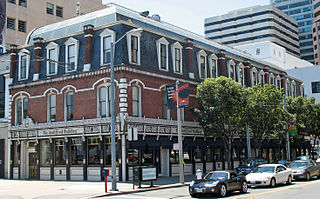
The Audiffred Building is a three-story historic commercial building in San Francisco, California, United States, formerly the location of waterfront bars and of the headquarters of a seamen's union, and now housing Boulevard restaurant. It is City of San Francisco Landmark number 7, and was listed on the National Register of Historic Places in 1979.

Hollywood Boulevard Commercial and Entertainment District is a historic district that consists of twelve blocks between the 6200 and 7000 blocks of Hollywood Boulevard in Los Angeles, California. This strip of commercial and retail businesses, which includes more than 100 buildings, is recognized for its significance with the entertainment industry, particularly Hollywood and its golden age, and it also contains excellent examples of the predominant architecture styles of the 1920s and 1930s. It was entered into the National Register of Historic Places in 1984.
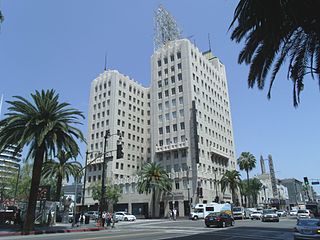
Equitable Building of Hollywood, also known as the Bank of Hollywood Building and The Lofts at Hollywood and Vine, is a historic twelve-story former office building, now condominium located at 6253 W. Hollywood Boulevard, Hollywood, California, at the intersection of Hollywood and Vine.

The Cinemart Building, also known as Seven Seas, is a historic three-story building located at 6904 W. Hollywood Boulevard in Hollywood, California. It is known primarily for its Golden Age of Hollywood tenant: restaurant and nightclub 7 Seas.
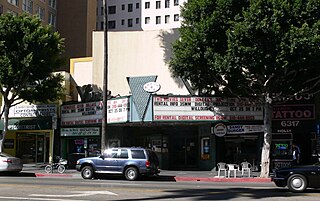
Vine Theatre, formerly Admiral Theatre and Rector’s Admiral Theatre, also known as Vine Street Theatre, Dolby @ Vine, and Dolby Screening Room Hollywood Vine, is a historic movie theater located at 6321 W. Hollywood Boulevard, near the intersection of Hollywood and Vine, in Hollywood, California.


















